Leicestershire
LEICESTER
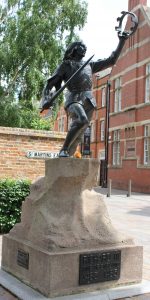
Richard III statue
The city may not be a natural tourist destination, but with the help of the last Plantagenet king, it's doing its best. When the remains of Richard III, slain at the Battle of Bosworth Field in 1485, were discovered beneath a car park in 2012, it attracted worldwide attention. After DNA analysis to confirm his identity, the king was reburied in the chancel of Leicester Cathedral (LE1 5DB) with appropriate ceremony. The tomb, plain but impressive, draws a steady stream of visitors.
Outside, a statue shows the king in a dramatic pose, sword in one hand, crown held aloft in the other. It carries a plaque offering a rather more sympathetic view of Richard than Shakespeare and the Tudors. Nearby, the Richard III Visitor Centre tells his story in full.
Like many provincial cities, Leicester was a centre of nonconformist worship, with the Baptist church particularly prominent. William Carey came here in 1789 as minister of Harvey Lane Chapel. It was during this time that he preached his famous sermon (actually in Nottingham), encouraging Christians to use means for the conversion of the heathen, rather than leaving the spread of the gospel to the passive forces of history. This led to the foundation of the Baptist Missionary Society and Carey is rightly regarded as the founder of the modern Protestant missionary movement.
The chapel, along with the rest of Harvey lane, has disappeared beneath the Holiday Inn hotel complex, seen as you enter the city from the east, but Carey is remembered with a small museum at the Central Baptist Church in Charles Street (LE1 1LA). Unfortunately, this is only accessible during church service times.

Robert Hall statue
Another Baptist minister, still remembered in Leicester although largely forgotten elsewhere, was Robert Hall (1764-1831), who has an impressive statue in De Montfort Square (LE1 7ER). Son of a baptist minister in Arnesby, Hall also served as minister at Harvey Lane from 1807 to 1826. Despite constant ill health, he was a conscientious preacher and writer, and was also involved in social affairs. Leicester was the traditional centre of the hosiery industry, and in 1819, when there was a severe recession due to industrialisation, Hall founded the Framework Knitters Friendly Society to help relieve hardship, reckoned to be the first ever Trade Union in Britain, and possibly the world. Today there is a Robert Hall Memorial Baptist Church in Narborough Road (LE3 0PD).

Thomas Cook statue
Yet another baptist preacher, although remembered for different reasons, was Thomas Cook (1808-1892), the travel pioneer. Growing up in poverty, Cook joined the Baptist church and for several years worked as a village evangelist, supporting himself by his trade as a cabinet maker. In 1829, he covered over 2,000 miles on foot around the villages of Rutland and Leicestershire. Cook was a keen supporter of the temperance movement and, while walking from Market Harborough to Leicester for a meeting (nearly twenty miles), he conceived the idea of using the growing railway network for organised travel.
Appropriately, Cook's statue is outside Leicester station, showing the railway pioneer with two leatherbound cases, consulting his pocket watch like the White Rabbit in Alice in Wonderland. His first organised excursion was on July 5th 1841, taking 500 people from Leicester to Loughborough for a temperance meeting, a distance of 11 miles. Other trips quickly followed, and organised visits to the Great Exhibition in 1851 helped the business to grow. Soon, travel to Europe, America and beyond became part of the Thomas Cook experience.
Thomas Cook's former offices are in Gallowtree Gate, near the Clock Tower (LE1 5YA). On the upper floors there are panels showing the various modes of transport used by the company at different times, including trains and a paddle steamer, with backdrops including the Crystal Palace, the Forth Bridge and the Nile.
LUTTERWORTH
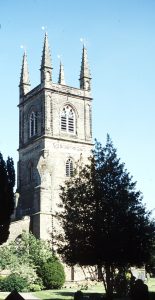
St Mary's, Lutterworth
This small town was the home of two men, six centuries apart, whose labours changed the world forever, but in entirely different ways. As we drive in, a sign reminds us that Lutterworth was the workplace of John Wycliffe (1324-1384) and also Frank Whittle, inventor of the jet engine. A model of Whittle's first jet plane stands on the roundabout at a junction approaching the town.
Wycliffe, came here as rector of St Mary's Church in 1374, and spent his final years translating the Bible into English, sending out his Lollard preachers and continuing his attacks on clerical abuse. He was buried in the churchyard, but forty-four years later his body was exhumed and burned and his ashes thrown into the river Swift.
The church (LE17 4AN) with its pinnacled tower is built of rounded sandstone blocks, giving a pebbled appearance. At the east end of the south aisle is a memorial to Wycliffe sculpted by R Westmacott in 1837. It is a marble relief showing him preaching to villagers while two monkish characters look on with disapproval. The pulpit and a chair kept beside the altar are both reputed to have been used by Wycliffe. A portrait painted in 1786 (posthumous by about 400 years!) also hangs in the church.
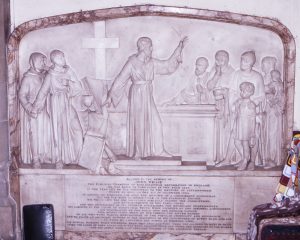
Wycliffe tableau
In the year of Queen Victoria's diamond jubilee, the citizens of Lutterworth clearly felt that their most famous inhabitant deserved a more substantial monument. A granite obelisk was erected on the corner of Bitteswell Road and George Street, just next to the Wycliffe Memorial Methodist Church. The lettering, recording the reformer's achievements, together with relevant Bible verses, has recently been highlighted in gold. Appropriately, the national headquarters of the Gideons organization, which distributes Bibles to schools and hotels is located here, a few yards from the memorial.
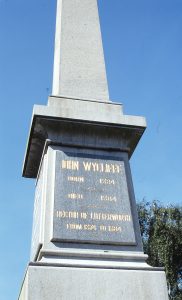
Wycliffe memorial obelisk
Born around 1324, Wycliffe was a native of Hipswell, near Richmond in Yorkshire. He was appointed of Master of Balliol College Oxford in 1360 and later held livings in several different parishes. He was a zealous reformer of clerical abuses and attacked ecclesiastical endowments, clerical celibacy, the mass and prayers for the dead. He was accused of heresy and cited to appear at St Paul's in 1377, but he enjoyed the support of John of Gaunt and the charges were dropped. In 1378, Wycliffe began his translation of the Bible which was the basis of all later English translations.
ASHBY DE LA ZOUCH
In the shire country between Leicester and Derby, there are memories of two noble families - the Ferrers and the Hastings - who have both lived here for generations. In the eighteenth century, a lady born into one of these families and married into the other was destined to become a significant figure in the evangelical revival. Selina, Countess of Huntingdon, daughter of the second Earl Ferrers, was born in 1707 at Wappenham in Northamptonshire, but grew up at Staunton Harold. In 1728, she married Theophilus Hastings, 9th Earl of Huntingdon, and bore him four sons and three daughters. Their marital home was Donnington Hall, but when her husband died in 1746, she moved to Ashby Place.
At the time, the life of an aristocratic lady was normally one of balls, banquets and gossip. In the 1730s, however, the note of revival was beginning to be heard, as George Whitefield and the Wesleys took the gospel message into the open air. One of their circle was Benjamin Ingham, and the earl's sister, Lady Margaret Hastings, was converted through his preaching and subsequently became Mrs Ingham. A fellow aristocrat sniffed that Lady Margaret had disposed of herself to a poor wandering Methodist. It was through her sister-in-law that Selina was drawn into evangelical circles and became one of the most important supporters of the Methodist movement. Her husband was tolerant of her views but never embraced them himself.
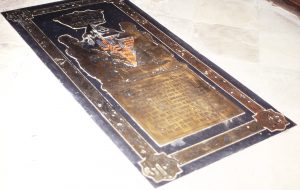
Countess of Huntingdon memorial brass
St Helen's Church in South Street (LE65 1AA) near the ruined castle has a chapel devoted to the Hastings family. When her husband died, Lady Huntingdon erected a handsome memorial with an epitaph by Lord Bolingbroke. She herself died in 1791 and is buried in the chancel of the church. The brass plate set into the floor quotes her final words My work is done. I have nothing to do but go to my Father. A medallion portrait by the Flemish sculptor Rysbrack can be seen in the Hastings Chapel and one of the west windows is dedicated to her memory.
Selina Hastings exercised her influence by using the aristocratic privilege of appointing able preachers as her chaplains. Some of these were men who had been refused ordination or promotion in the church for "enthusiasm". If they preached within her homes or private chapels they avoided the constraints imposed by hostile vicars or bishops. Her list of chaplains included, at various times, William Romaine, John Berridge and George Whitefield. Owning or renting houses in London and many fashionable resorts, she would invite her chaplains to preach to her distinguished circle beneath the chandeliers, just as they preached to ordinary folk beneath the open skies. While many of her guests remained sceptical or indifferent, a small but significant number became committed Christians.
She tried to remain within the confines of the Church of England, but towards the end of her life eventually withdrew and registered her own chapels for non-conformist worship. Most of her Anglican chaplains resigned. She founded a college in Wales for training preachers and supported missionary work in the new American state of Georgia.
STAUNTON HAROLD
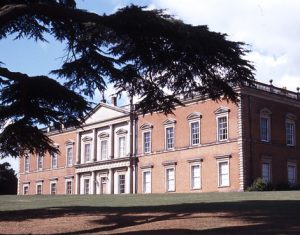
Staunton Harold mansion
Tucked away in countryside just north of Ashby de la Zouch, the setting of this estate has been described as unsurpassed in the country. There is a garden centre and nursery, a stable block now used as a craft centre, a historic church and Palladian mansion with lawns sloping down to a lake. The church (LE65 1RW) was built by Sir Robert Shirley in 1653 at a time when all things sacred were throughout ye nation either demollisht or profaned, as the intriguing inscription on the outside declares. Sir Robert was a Royalist and the church was a statement of his High Church principles in defiance of Cromwell's Commonwealth.
The Ferrers Centre for Arts and Crafts gives a clue to the former occupants. The mansion was originally the home of the Ferrers family (Shirley is the family name) and Selina, daughter of the second Earl Ferrers, was brought up here. She later became the Countess of Huntingdon. The mansion was rebuilt in 1763 but incorporates parts of the earlier house. Until recently it was used as residential care home but has now reverted to private ownership.
FENNY DRAYTON

George Fox memorial
Just off the busy A5, this was the birthplace of George Fox (1624-1691), founder of the Society of Friends, better known as the Quakers. At the point where George Fox Lane meets Old Forge Road a stone obelisk erected in 1872 marks the site of his former home (CV13 6BD).
Fox was son of a devout weaver called Christopher Fox, known to his neighbours as "Righteous Christer". After long spiritual struggles, he began to preach his own version of non-conformity, which emphasized the "inner light", rather than formal creeds or doctrines. This brought him into conflict with both civil and church authorities and Fox and his followers endured frequent spells of imprisonment. We meet him in many other places usually in trouble with one authority or another.
Despite their turbulent beginnings, the Quakers gradually gained a reputation for absolute integrity in business and personal affairs. Excluded from universities and government appointments, they often prospered in industry and commerce.
KIBWORTH HARCOURT
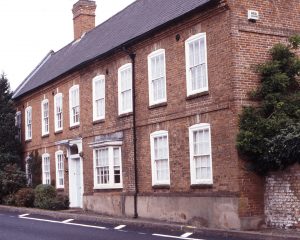
John Jennings academy
At the point where the road through the village meets the busy A6 to Leicester is a handsome house - so long that it could once have been two or more separate cottages. It is called the White House (No 53) and now carries a blue plaque (LE8 0PX). In the early eighteenth century, this was a non-conformist academy of John Jennings and one of his pupils was the hymn writer Philip Doddridge (1702-1751) who came here at the age of seventeen. Doddridge later became a teacher here and used this as the model for his famous college in Northampton.
About a hundred yards to the north on the same side is the Congregational Chapel (No 79) founded by Jennings and attended by Doddridge. The windows have leaded glass in unusual shapes. There is also a link with Thomas Cook who, before starting his travel company, was a Baptist missionary in these parts. In 1994, plaques in memory of Cook were placed on the wall of this and several other chapels, marking the 150th anniversary of the founding of the company.
ARNESBY
The Baptist preacher Robert Hall (1764-1831) was born here, the youngest of fourteen children. His father was minister of the Baptist chapel, next to the Old Cock inn, although the present building is later (LE8 5WJ). Hall became assistant minister at Broadmead Chapel in Bristol in 1785. He was renowned for his eloquence but fought a continuous battle against pain and suffering, and on two occasions completely lost his mind, probably due to the drugs he was prescribed.
In 1807, he became minister at Harvey Lane Baptist Church in Leicester, where he preached for twenty years. He was involved in social welfare projects, organising relief for unemployed stocking workers and pioneering early forms of trade unionism.


